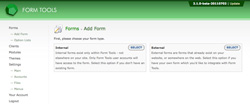Form Types
Form Management
There are three types of forms in Form Tools: Internal, External and Form Builder forms. When you click on the "Add Form" link in the menu, it will direct you to a page where you need to choose one of the following types. Here's what each type means:
Internal forms are created within Form Tools and are only available within the Form Tools interface - i.e. there's no publicly available form and only Form Tools user accounts will have access to the form. You create and configure the form directly through the interface. Learn More
External forms are forms that you create manually yourself, and exist on your own website - or somewhere on the web. External forms are completely separate from Form Tools: any changes you make to them (new fields, etc) force you to update the Form Tools form configuration separately to ensure the data is kept in sync. The benefit to External Forms is that it imposes no limitations on what your form looks like or functions, however it comes with the downside that you always have to manually update the form configuration in Form Tools to reflect the state of your form. Learn More
Form Builder forms are available if you have the Form Builder module installed. By default, that module is included in all downloads. Form Builder forms are similar to Internal Forms in that they are created and managed entirely within the Form Tools interface. However, the Form Builder module lets you actually publish your form right on your website for the public to use. Learn More
Note: if you're just getting started, don't worry about picking the wrong one! Form Tools is very flexible: you can always change the form type down the road. And not just that. If you need your form to be fed data from multiple sources, you can do that too. So if you wanted, you could have a Form Builder form published on your site, but also have dozens of other forms - all containing different fields and styles, feeding the same form in Form Tools. I'm really not kidding when I say Form Tools is flexible.
